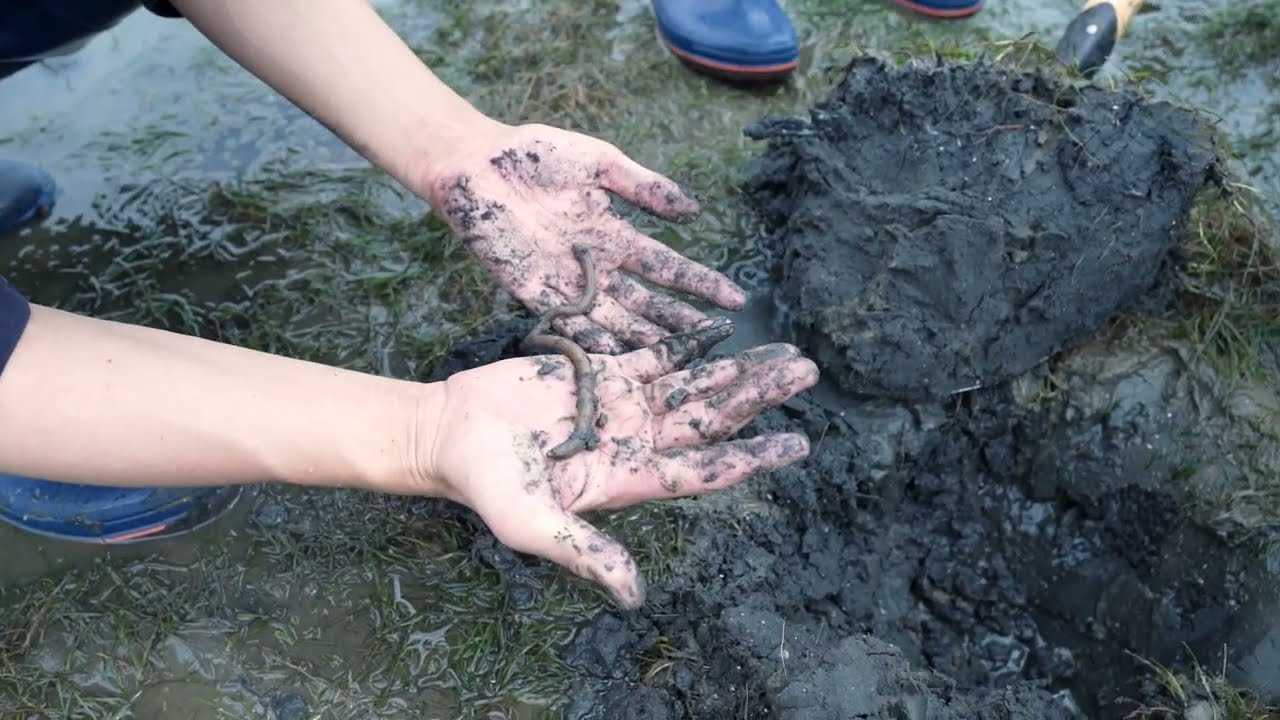Marine Biology with Laboratory & Field Work 1
(2) Observing the animals of the tidal flats with biological identification Ryutaro Goto (Assistant Professor, FSERC)
*Note that the ship sometimes swayed on high waves
[Seto Marine Biological Laboratory]
The laboratory was established in 1922 at Shirahama Town, Wakayama prefecture. Throughout its history, the laboratory has been one of center places in Japan to study systematics, ecology and other natural history sciences of marine invertebrates. The laboratory has been visited by hundreds of distinguished scientists from all over the world for their research and also used for education for university students from various parts of Japan. The laboratory holds Shirahama Aquarium as an adjunct facility and Hatakejima Island as a protected area. The neighboring coastal areas are composed of diverse environments such as steep cliffs, bays of various sizes, sandy beaches, rocky shores, and mudflat. The climate is mild, which is influenced by the warm oceanic current Kuroshio, and the marine flora and fauna are exceptionally rich.
-

- (1) On-board sampling and microscope observation of marine plankton
-
Mariko Kawamura (Researcher, FSERC) Hiroki Yamauchi (Technical staff, FSERC) Kohki Yamamoto (the Captain, Technical staff, FSERC) Keisuke Koizumi (Doctoral Course, Graduate School of Science)
Aug. 23, 2021 36:04 Japanese, English
-

- (2) Observing the animals of the tidal flats with biological identification
-
Ryutaro Goto (Assistant Professor, FSERC)
Aug. 23, 2021 25:17 Japanese, English
-

- (3) Observing the animals of the rocky shore with biological identification
-
Tomoyuki Nakano (Junior Associate Professor, FSERC)
Aug. 23, 2021 19:54 Japanese, English
Details
- Year/Term
- 2021
- Faculty/
Graduate School - Faculty of Science, Field Science Education and Research Center
- Language
- Japanese, English
- Instructor name
- Tomoyuki Nakano(Junior Associate Professor, FSERC)
Ryutaro Goto(Assistant Professor, FSERC)
Mariko Kawamura(Researcher, FSERC)
Hiroki Yamauchi(Technical staff, FSERC)
Kohki Yamamoto(the Captain, Technical staff, FSERC)
Keisuke Koizumi(Doctoral Course, Graduate School of Science)
- Place
- Seto Marine Biological Laboratory
Syllabus
| No. | U-SCI00 22733 EJ69 | Term | 2021・Intensive, First semester |
|---|---|---|---|
| Number of Credits | 2 credits | Course Type | Practical training |
| Target Year | 2nd year students or above | Language | Japanese |
| Instructor name | ASAKURA AKIRA (Field Science Education and Research Center Professor) SHIMOMURA MICHITAKA (Field Science Education and Research Center Associate Professor) NAKANO TOMOYUKI (Field Science Education and Research Center Junior Associate Professor) GOTO RYUTARO (Field Science Education and Research Center Assistant Professor) |
||
| Outline and Purpose of the Course | 生物多様性学に重点を置いた実習である。海洋生物の系統分類学的および生態学的多様性の基礎を学ぶことを目的とし、乗船・磯や干潟での海産無脊椎動物の観察や採集、さらに各種顕微鏡によるプランクトンの観察やウニ類の発生観察などを行う。 場所は、フィールド科学教育研究センター瀬戸臨海実験所(和歌山県白浜町)にて行う。 |
||
| Course Goals | 生物多様性学的立場から、潮間帯から浅海域に分布する代表的な海洋生物の系統分類学的多様性、生態学的多様性に関する基礎的な知識を習得する。 |
||
| Schedule and Contents | ・海洋生物の多様性および進化系統分類についての基本的な知識の取得を目指し、潮間帯や潮下帯に生息する様々な動物門のベントス・プランクトンを採集し、観察・分類等の実施(実験所周辺あるいは畠島の岩礁潮間帯や干潟での採集。研究船ヤンチナに乗船し、ドレッジや採泥器を用いて海底堆積物を採取し、試料からベントスを分別、またプランクトンネット曳き採集)。 ・ウニ類の正常発生の観察。ウニ類と同じ棘皮動物に属するナマコ類や、系統的に離れた位置にある環形動物・軟体動物等との初期発生の比較。 |
||
| Study outside of Class (preparation and review) | 理学部の講義「海洋生物学」、「無脊椎動物学」と内容的に深い関連があるので、あわせて履修することが望ましい。 |
||
| Textbooks/References, etc. | 無脊椎動物の多様性と系統(節足動物を除く), 白山義久(編), (裳華房), ISBN:9784785358280 節足動物の多様性と進化, 石川良輔(編), (裳華房), ISBN:9784785358297 干潟の絶滅危惧動物図鑑―海岸ベントスのレッドデータブック, 日本ベントス学会(編), (東海大学出版), ISBN:9784486019435 干潟ベントスフィールド図鑑, 鈴木 孝男ほか, (日本国際湿地保全連合), ISBN:9784990423889 干潟の生きもの図鑑, 三浦知之, (南方新社), ISBN:9784861241390 写真でわかる磯の生き物図鑑, 有山啓之, 今原幸光, (トンボ出版), ISBN:9784887161764 潮間帯の生態学, 朝倉彰 (翻訳), (文一総合出版), ISBN:9784829921395 海洋ベントスの生態学, 日本ベントス学会(編), (東海大学出版), ISBN:9784486016199 天草の渚―浅海性ベントスの生態学, 菊池泰二(編), (東海大学出版), ISBN:9784486017035 そのほか、海産の無脊椎動物が載っている図鑑や無脊椎動物のテキストなど |
||

